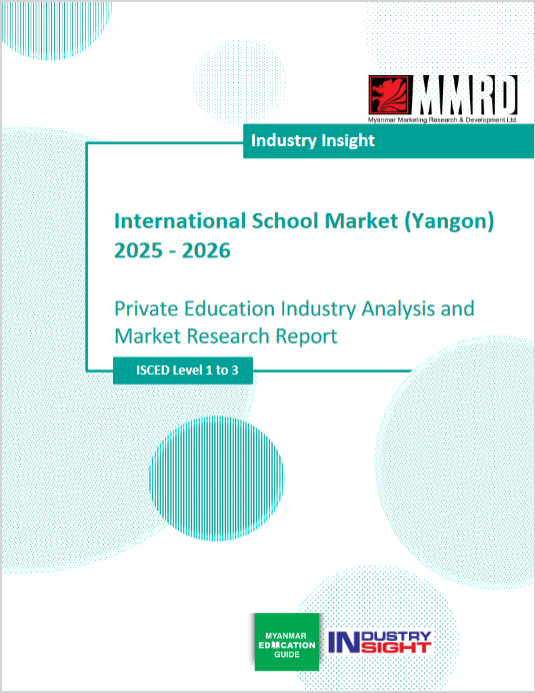Report Structure
The report begins with an Introduction, which establishes the research framework and key classifications, such as the International Standard Classification of Education (ISCED). It also includes an analysis of Yangon’s relevant school-age population and the report’s geographic focus.
“This Yangon market analysis includes primary data gathered through surveys and interviews, and it is largely and formally based on MMRD’s own database. Secondary data from reputable sources are also analyzed. The geographic focus area is Yangon, which is the hub of international education in Myanmar. ISCED classification is applied for the analysis.”
Landscape of Private Basic Education
This section provides essential context by exploring the broader growth of the private education sector. It offers a detailed overview of international schools in Yangon and identifies the key driving factors and the legal and regulatory framework that shape the market.
“In the 1990s, the government began to relax its restrictions on private schools, and the sector began to grow rapidly. Yangon’s private international school sector includes a diverse range of schools, from small, locally run institutions to larger, internationally affiliated schools. Quality in private schools can vary widely. Some schools invest heavily in infrastructure, teacher training, and extracurricular activities, while others may face resource limitations.”
Market Insights and Findings
This section transforms raw data into strategic intelligence, detailing critical market metrics such as the number of schools, geographic and curriculum distribution, and student enrollment patterns. It also includes a comprehensive pricing analysis and an in-depth competitive landscape review.
“At least 136 international schools operate within the city. The market is predominantly shaped by the British curriculum. Fee levels tend to increase progressively with grade level.”
Market Segmentation Analysis
This section provides a focused view of the market across various ISCED levels (Primary, Lower Secondary, and Upper Secondary), examining the evolving dynamics in post-Year 9 private education pathways.
“The report provides a detailed analysis of student distribution by school size (small, medium, large), as well as a pricing analysis across three tiers (budget, mid-range, and premium). This data is segmented by educational level, with the market value of each level also provided. The report also compares student enrollment and average annual fees for the Primary, Lower Secondary, and Upper Secondary levels.”
Market Value Estimates
This section quantifies the market size, providing robust data on student numbers, total market value, and market share. This financial intelligence is vital for informing strategic planning, investment decisions, and financial forecasting.
“Even though the number of students decreases significantly at higher levels, the market value per student increases substantially. Primary Education is the largest segment, comprising 64% of students. It also contributes the most to the overall market, accounting for 54% of the total market value.”
Market Trends, Challenges, and Outlooks
The report concludes with a forward-looking analysis of market trends, challenges, and outlooks, offering insights into opportunities and potential risks within the industry. It serves as a critical tool for navigating Yangon’s international school market, providing a holistic view and detailed analysis to help stakeholders formulate effective strategies for future growth.
“The Yangon international school market shows a sharp contraction in student numbers between 2019–2020 and 2023–2024, followed by a strong rebound projected for 2025–2026 to pre-2020 levels. In contrast, market value in Myanmar Kyat (MMK) has risen steadily across the same period, driven by currency depreciation and fee adjustments, highlighting how enrollment recovery and local currency inflation are influencing overall market growth.”
Why This Report
- Covers ISCED Levels 1–3 (Primary, Lower Secondary, Upper Secondary)
- Forecast across 130+ institutions in Yangon’s urban areas
- Backed by MMRD’s 30+ years of market research
- Combines primary surveys, interviews, and trusted secondary data
About MMRD
With over 30 years of industry research experience, Myanmar Marketing Research & Development (MMRD) provides high-quality data and analysis across Myanmar’s economy. MMRD also publishes trusted directories including:
Yangon Directory – Myanmar’s yellow pages since 1992 (www.yangondirectory.com)
Myanmar Education Guide – No.1 education portal with 26,000+ listings (www.edge.com.mm)
